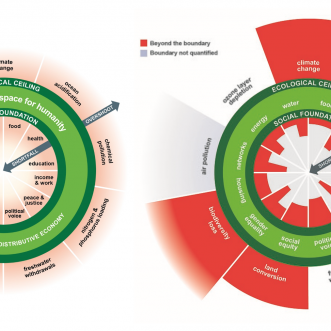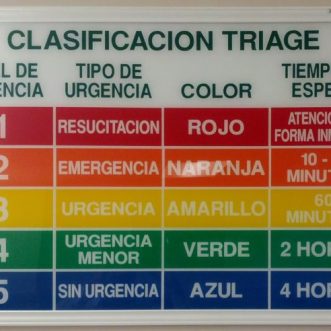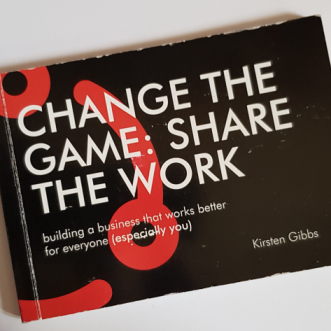
Lining up
A bridge only works when everything is properly lined up. We don’t expect anyone to be able to build a … Read More “Lining up”

A bridge only works when everything is properly lined up. We don’t expect anyone to be able to build a … Read More “Lining up”

In an earlier post, I asked why it’s deemed important to report on the FTSE 100 index at every news on the radio, and what relevance that index has for most ordinary people.
There are alternative things to measure, that matter more to most people, and I think Kate Raworth’s doughnut pretty much captures them all.
What if instead of the FTSE, we had a daily snapshot of our impact as a nation on overshooting the ecological ceiling, or undershooting the social foundation? What if we could see every day how well we are doing at keeping within “the safe and just space for humanity”.
Like the FTSE and other indices, this snapshot would be made up of data from millions of enterprises large and small across the country, and that means that each enterprise would need to measure it’s own impact too.
That’s completely doable, if we set our mind to it, with the help and support of our accountants.
Why wait? Let’s start now.

In 2011, the city of Sao Paulo banned billboards and logos from it’s streets and buildings.
Despite protest from advertisers, the move made hardly any difference to the economy of the city. People still bought stuff. The only people who lost out were the people selling advertising space.
Which raises three interesting questions.

One reason why we can feel overwhelmed at work, is that we don’t use triage enough.
Simple triage for unexpected client phone calls and emails:
Every customer has top priority. That needs managing.

Bernadette Jiwa has a real gift for encapsulating the essence of a problem in few words. I’ve had these 3 questions from a hypothetical customer running round my head for a couple of weeks now, as I work out how to apply them to what I doing.
My new book is out soon, so I thought I’d give answering them a go:
Why this?
Because all the small business owners I’ve met want 3 things:
They need to make profit to do that effectively. This book gives ideas for how to approach the first two in a systematically different way, to get more of the third.
Why you?
Because I’ve used this approach to help businesses achieve all 3 of their goals, and I want to teach more business owners how to do it for themselves.
Why now?
Because if we want a better world for everyone (if we want a world we can live in at all), we have to find a better way of doing business. This won’t come from the top, so we small business owners must make it happen from the bottom up.
That was an interesting exercise. What would you answer?

Aversion to new kinds of food is an instinct that kicks in for humans at around 2 years old. It’s a safety mechanism, evolved to protect the species. Just when they start toddling about, beyond the immediate reach of adults, children become extremely wary of whatever goes into their mouth.
As all parents know, this causes huge problems, when you’re just trying to get them all fed properly. This wariness can fossilise into a refusal to try anything new, leading to a choice between becoming what my mum used to call ‘A Marks and Spencer cafeteria’, or turning mealtimes into battles.
A non-stressful way to handle this wariness, is to give it its due attention, and give children time to overcome it themselves. Instead of putting new foods in front of them and expecting them to try them immediately, you introduce new foods as part of play.
Playing with carrots, broccoli, blueberries, with no expectation of having to eat them seems to release a child’s natural curiosity, and from painting with beetroot, it’s a small step to tasting it. Before you know it, your children are happy to try new things, mealtimes are enjoyable again, and you’re cooking the same meal for everyone.
Once you understand why children get fussy about what they eat and take it seriously, the right approach becomes obvious.
As I was watching this on TV, I wondered whether a similar approach might work with adults and work. Perhaps, if we can find ways of letting people play with changes, with no obligation to make them, we might unleash their natural curiosity and creativity and so not only end up with happier people, but better changes too.

Sport has long recognised ‘Muri’ – wasted effort through overburdening people, equipment or systems. An unrelenting schedule of high-intensity training is counter-productive. Eustress, the beneficial stress of additional effort that leads to improved performance, is more than offset by injury and exhaustion, or distress. Athletes burn out, physically and mentally.
The answer they’ve found is simple: build in short periods of recovery between longer periods of intensity. That doesn’t mean the athletes do nothing, simply that they are training at a lower level that prevents distress. These short recovery periods allow bodies and minds to recover, but are not long enough to allow a slide back to the previous performance level.
The result is a series of systematic, and predictable step-wise improvements in performance, that can be planned to coincide with major targets, such as a local, national or international competition, or the Olympics.
It seems to me that businesses could learn a lot from this approach.
Huge thanks to Matthew Cunliffe for this insight.

Pinpointing who you are for as a business makes it much easier to share your Promise effectively and efficiently.
The people you wish to serve become much easier to find when you know who exactly who they are demographically. If you start a new bus service on a route that is not currently covered, you know exactly where to look for potential passengers.
The people you wish to serve become much easier to find if you know who they are psychographically too. If your new bus service uses luxury coaches with attendants, snacks and entertainment, you know which subset of potential passengers you need to appeal to, and probably what you need to say.
Of course, you need to find out whether there are enough of these people to make your bus service viable before you start it.
But if you know who you’re looking for, that’s easier too.

Assuming that your Promise of Value is already in the intersection of things profitable and things useful, how do you make it better?
Here are a few ideas:
A simple way to test the result is to try and express it in this form:
“We do X. Y people do/achieve/become Z because we do.”
Huge thanks to the brilliant Bernadette Jiwa for this format.

If a business is about making and keeping promises, what does better mean?
Making more promises? Or keeping more?
Making our promises better? Or keeping them better?
A good place to start might be to make better promises. After all, the set of all useful things and the set of all profitable things do not fully correspond.
Better starts with finding our place in the intersection.